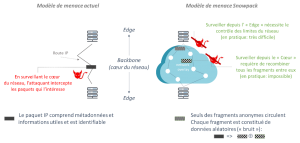
Currently, data are exchanged over the internet in the form of packets, which include the data of interest, plus metadata such as IP addresses needed to deliver the data. The data can be protected using encryption. The metadata, however, remain visible, creating a vulnerability that hackers can exploit to very easily determine the identity and location of the sender and the recipient and, in some cases, access the encrypted data.
Data anonymization techniques do exist. These can entail using a trusted third-party to mask the sender’s, the recipient’s, and data subjects’ true identities. However, this information can still be seen by the third party. Over the past two years, successful cyberattacks exploiting this vulnerability have shown just how fragile today’s protection is.
CEA-List came up with a particularly innovative solution to enhance data anonymization and better protect data exchanges online. The data packets are divided into fragments made up of random but complementary data; these fragments are then anonymized and transmitted over separate pathways. This makes it impossible for hackers to get to sensitive data simply by observing the network used to transmit the data.

In practical terms, it is also impossible for hackers to effectively monitor all of the fragments traveling over a network for a given message. And, even if hackers could find all of these apparently unrelated fragments, they would not be able to put them back together in a coherent manner, rendering them effectively useless.
CEA List’s novel approach offers protection against mass network monitoring software, drastically reduces the area visible to hackers, and eliminates the need to use trusted third parties. Prototypes of the solution have been tested with success, and two patents have been filed to protect it.
Startup Snowpack, a spinoff of CEA List, was founded to develop and commercialize this technology. The company has set the ambitious goal of becoming the leading online data anonymization and security platform. The solution will be easy to integrate into software products and services, where it will seamlessly replace today’s solutions.